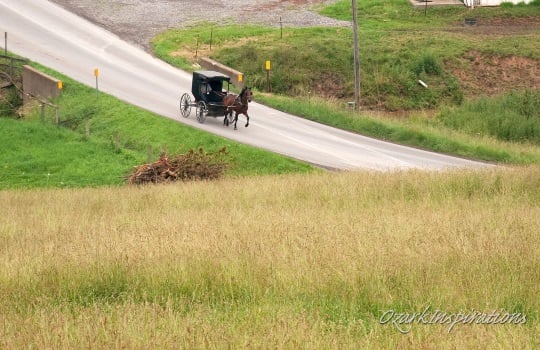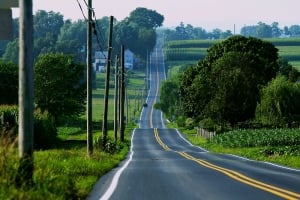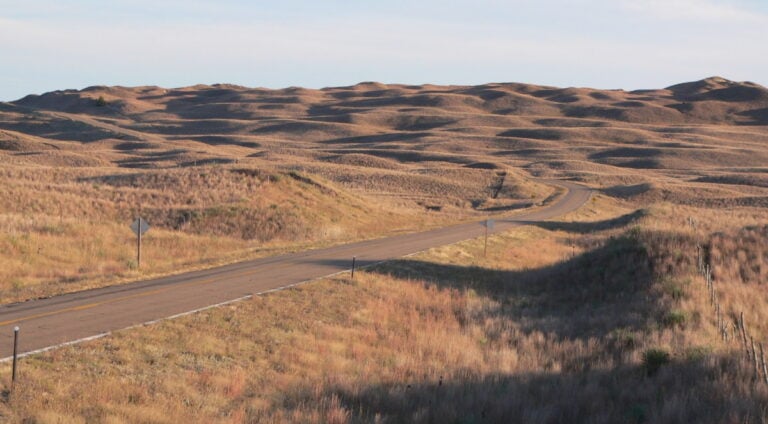The 10 Biggest Amish Communities (2023)
Half of them are in Indiana. Two apiece in Pennsylvania and Ohio. And one in Illinois.
The list of the top 10 largest Amish settlements doesn’t change much from year-to-year.
These places generally have similar steady growth, and relatively few people leaving.

Photo by Don Burke
Still, I like to do a fresh post from time to time on the largest communities. The last came in 2017.
This year I’m taking a slightly different approach.
As before, below you’ll find the 10 largest communities, along with the number of people, number of church districts, and year founded (numbers from the Young Center’s latest figures).
But this time around I’ve also provided:
- Main counties where Amish can be found in that particular settlement
- Key towns which are hubs of Amish activity and places of visitor interest (not exhaustive; I’ve listed some of the main ones, especially for the larger settlements).
- A map showing where each community is located in the state
- Interesting facts about each settlement
Credit also goes to Joseph Donnermeyer and David Luthy, who do yeoman’s work compiling comprehensive Amish settlement listings. I’ve used some of their info in this post.
The Top 10 Biggest Amish Settlements (2023)
1. Lancaster County, Pennsylvania

Founded: circa 1760
Population: 43,010
Church districts: 252
Counties where Amish are found: Lancaster; Chester; York
Key towns: Intercourse; Bird-in-Hand; Strasburg; Quarryville; Leola; Gordonville; Gap
Did you know? Lancaster County is also home to a large Old Order Mennonite community. One of the most common Amish names is “Stoltzfus“. An alternative, rarer spelling you will find in Lancaster County is “Stoltzfoos”.
2. Holmes County, Ohio

Founded: 1808
Population: 38,635
Church districts: 308
Counties where Amish are found: Holmes; Wayne; Coshocton; Tuscarawas; Stark
Key towns: Berlin; Walnut Creek; Mt. Hope; Charm; Mt. Eaton; New Bedford; Sugarcreek
Did you know? The Holmes County community is the most diverse in terms of different Amish groups. There are four main affiliations, and at least 11 distinct Amish groups represented in this settlement, from the Swartzentruber Amish to the New Order churches. Holmes County proper is the “most Amish” county in the nation, with over 40% of those living within county boundaries belonging to a horse-and-buggy Amish church.
3. Elkhart-Lagrange Counties, Indiana

Founded: 1841
Population: 27,815
Church districts: 209
Counties where Amish are found: Lagrange; Elkhart: Noble
Key towns: Shipshewana; Topeka; Middlebury; Millersburg; Lagrange
Did you know? Most adult males work in the RV industry, a mainstay here dating to the 1960s. Amish men here often wear winter caps aka “toboggans” in lieu of the traditional hat.
4. Geauga County, Ohio

Founded: 1886
Population: 19,900
Church districts: 154
Counties where Amish are found: Geauga; Trumbull; Ashtabula; Portage
Key towns: Middlefield; Burton; Parkman; West Farmington
Did you know? There are two main affiliations of Amish in the Geauga County settlement, the “mainline” group, and the smaller plainer group known as “Number Twos”. Maple syrup is a big industry in this region, and you will find some Amish producers and sellers in the area. Amish here use ice for cooling, and get it from coolers scattered throughout the community.
5. Adams County, Indiana

Founded: 1850
Population: 11,080
Church districts: 66
Counties where Amish are found: Adams; Jay; Wells; Mercer County, OH
Key towns: Berne; Geneva; Monroe
Did you know? This is the largest “Swiss Amish” community. The Amish here are known for having buggies without tops, though recently one or two churches have begun permitting them. You’ll notice different last names here which are uncommon in non-Swiss communities, including Schwartz, Eicher, and Hilty.
6. Nappanee, Indiana

Founded: circa 1841
Population: 6,570
Church districts: 50
Counties where Amish are found: Elkhart; Kosciusko; Marshall; St. Joseph
Key towns: Nappanee; Bremen; Wakarusa
Did you know? Nappanee‘s town slogan is “Embrace the Pace”, fitting for a town at the heart of a thriving community of horse-and-buggy drivers. Amish Acres is a large tourist attraction in the area. Of the ten communities on this list, this and the Elkhart-Lagrange settlement lie the closest to one another, and in recent years have even begun to “overlap”.
7. Daviess County, Indiana

Founded: 1868
Population: 5,760
Church districts: 35
Counties where Amish are found: Daviess; Martin
Key towns: Montgomery; Cannelburg; Odon
Did you know? You can usually tell an Amish person from Daviess County by their accent, which has a Southern-sounding twang. This would be the most southern on the map of the ten settlements listed here.
8. Arthur, Illinois

Founded: 1864
Population: 4,360
Church districts: 31
Counties where Amish are found: Douglas; Moultrie; Cole
Key towns: Arthur; Arcola
Did you know? This very flat, corn country community is home to a thriving furniture industry and events including auctions and an annual cheese festival running for over 40 years.
9. Big Valley, Pennsylvania

Founded: 1791
Population: 4,240
Church districts: 34
Counties where Amish are found: Mifflin; Huntingdon
Key towns: Belleville; Allensville; Reedsville
Did you know? This community is famous for its three distinct Amish groups, easily identified by their black, white, and bright yellow buggies (though there are subgroups as well). The official name of the 30-mile long valley where the settlement is found is Kishacoquillas Valley. It was named after a friendly Shawnee Indian chief. Another nickname is “Kish Valley.”
10. Allen County, Indiana

Founded: 1852
Population: 3,645
Church districts: 26
Counties where Amish are found: Allen
Key towns: Grabill
Did you know? There are almost no traditional farmers left in this Swiss Amish community. If you are an Amish male of working age in Allen County, odds are you are in the construction industry.
There are over 600 Amish settlements in the world (primarily in the US and Canada).
There are approximately 373,620 Amish on the planet today.
The top 10 communities make up around 45% of the total Amish population.







Where is Shipshewanna Indiana
Sorry I don’t know how to spell Shipshewanna, but from what I’ve been told it’s a rather large community, and people from Holmes County will bus there at times to see the shops there. I couldn’t find it on your maps, but I know it is in Indiana.
Donna
Hi Donna, Alice Mary is right below, Shipshewana is in northern Indiana – it is listed as one of the main towns in #3 above. Sometimes you might hear people refer to a settlement by the name of the main town (eg, sometimes people refer to the Allen County, IN community as just “Grabill”). Shipshewana would be the tourism heart of that community. It’s a nice settlement well worth visiting if you get the chance.
Hi, Donna!
I’ve been to Shipshewana & Middlebury a couple of times on bus tours. I believe they’re roughly in Northern Indiana (northwest or north central edge of the state.) Nice shops, quaint Mercantile building (Shipshewana) with a beautiful merry-go-round on the top floor. I noticed several Mennonite women working in some of the shops in the Mercantile. The area is also known for the Amish (not all Amish, for sure!) “flea market” held mid-week…don’t know if it’s year-round, as it’s outside. There’s also a big auction house where I saw some interesting (and familiar to me) antiques. That, I believe, is open year-round.
Our group stayed in Middlebury at Das Essenhaus (the eating house, we were told), which has a wonderful “Amish” type restaurant with many Amish servers/employees. Loved the fresh baked strawberry-rhubarb pie. It’s closed Sundays (as are all Amish shops). It also has a very beautiful hotel with gorgeous landscaping and Amish buggy rides and more.
Erik, I was surprised to see the Arthur Amish still on this list! It makes me wonder about the current birthrate in all those communities.
Thanks for publishing this useful list (my “bucket list,” you might say!)
Alice Mary
Glad you liked it Alice Mary, I have not heard anything about Arthur’s growth slowing for reasons like declining birthrate or a lot of out-migration. I expect it will stay on the list for a long time to come:)
Shipshewana, Indiana Fleas Market
Mary- There IS a Auction held each week throughout the year there, but the ” outdoor flea market ” only runs late spring through early fall season and then only in Tuesdays and Wednesdays.
**However**
There is also a traveling flea market team that traverses Indiana and Ohio for sure, during winter months.
Those are wonderful as well, and only on Saturdays and Sundays consecutively, for the biggest crowds. Love them!
Trading Places
I’ve heard for years that Holmes County and environs were the home of the largest group of Amish in the world. Now I see than Lancaster, PA has taken its place as first.
When did that happen?
Is Lancaster County or Holmes County the largest Amish settlement?
Well, good question, as they are both quite similar in size, and I’ve seen the claim made before about both. The figures that these lists are based on are provided by the Young Center at Elizabethtown College, who compile estimated numbers annually.
About 9 years ago, they began placing Lancaster County as slightly ahead of Holmes County. https://amishamerica.com/pennsylvania-amish-edge-out-ohio-in-latest-amish-population-figures/
You’ll see above that Lancaster County actually has significantly fewer church districts total (235 vs. 288), but the folks at the YC have found that the average church district size in Lancaster County is significantly larger on average than that in Holmes County.
You can read more on how this is figured at the YC site here: https://groups.etown.edu/amishstudies/statistics/twelve-largest-settlements-2019/
Home Away from Home
Believe I read single arrive on Jamesport MO.
Family Friendly Not Forgotten Visit.
Initialy went to shop horse harness and keep coming back for FFNF. Wonderful people, shopping, restuarant.
I like the way you added the counties and towns under the settlement name. Until you explained that a couple weeks ago, I didn’t realize that was how they were considered settlements as opposed to counties. It’s interesting to to say the least and totally makes sense.
Glad you found that useful Kim. Our discussion on that actually made me think it might be useful. Joe Donnermeyer and David Luthy’s settlement list was particularly helpful on that detail.
I, too, enjoyed this post, especially with the additional information such as counties, key towns and “Did You Know?”. Regarding the Elkhart-Lagrange settlement, I’m wondering if there are a few families who now live in St. Joseph County, Michigan. It seems like I remember reading a few months ago in The Budget newspaper in a scribe’s news from a district north of Shipshewana that one of their district’s families had just moved to a homestead right across the border in Michigan. I visit the settlement at least once each year and it seems like each time I go, I learn that the settlement has spread even further out. I remember when I first heard there were families who lived way south in the Cromwell area, then I also remember when I first heard there were families living way northwest in the Bristol area.
Al, good that you pointed that out – I thought to mention those, as I’d heard there were families living on the Michigan side already years ago, but wasn’t sure if that was still the case, or if it was even a significant number of families. In this case to keep it simple, for the counties entry I just went with what was described in the sources I referenced above. I do wonder how many families might be living on that side of the state line though.
I’m going to be in the Elkhart-Lagrange area late this fall, so will ask around to see how many families of the settlement now live in Michigan and let you know.
Thanks Al, that’d be great.
St. Joseph County
I know some Amish people in St. Joseph County, Michigan. There have been Amish there for 100 years, but it never grew much. But in recent years, it is almost a ‘fad’ (one Amishman’s comment to me) to move there! Cheaper land, but only about 15 miles from Shipshewana in the Lagrange/Elkhart County settlement – too far for most horses to make a round trip, but they sometimes do the trip by bicycle!
I have a 2006 Michigan Amish directory. (I do a lot Amish genealogy, as well as write a blog about the Amish in Lagrange/Elkhart counties, where I live, so I have a shelf-full of old Amish directories!)… It lists 8 church districts for Centreville, the largest Amish-settled town in Michigan. The towns of Clare and Quincy were next with four districts apiece.
However, that was 13 years ago and they likely all have grown, especially Centreville. The draw there is mostly cheaper land – plus it is close enough to ‘commute’ by carpool to RV factory jobs south across the border to Indiana, which so many Amishmen do until they can set up a business of their own.
Susan, your blog is great! I will enjoy looking at more of your posts and photos. Do you write mainly about Elkhart/Lagrange/Nappanee, or ever about say the communities around Fort Wayne (Allen & Adams Counties)?
I visited St. Joseph County about 8 years ago, enjoyed it. https://amishamerica.com/amish-centreville-st-joseph-county-michigan/
You are right, it is pretty old, and not huge for its age, but over 100+ years with all the variables affecting growth that thatt time span could include, it’s hard to say exactly what an “expected size” would be. There are some communities that are about the same age or older and a lot smaller. The community is now up to 12 church districts, according to the freshest info I have. When I visited (c. 2011), it was 11 districts, so looks like it’s grown a bit but I’d expect more than that in 8 years’ time, unless people are moving out often.
But interesting to learn the area has recently become more attractive for N. Indiana Amish.
Southern MI Amish communities
There are a number of Amish farms in the Coldwater (Branch County) and Tekonsha (Calhoun County) areas. There was an Amish couple who would sell their baked goods in an antique store in Allen. They would tether their horse and buggy along the side of the building, and would set their wares on a table inside the building. Great selection of goods. Also, if one were to travel down M 66 South of the Battle Creek area towards the Three Rivers/Sturgis areas, one will pass many lovely Amish farms. They have occupied this area for many years.
Elkhart/Lagrange/Nappanee, southern Michigan
I live in Syracuse,IN which is the far northern part of Kosciusko county and southern Elkhart county. We have had several Amish families move into town in the last 5 years. We also have several more that own houses here and use them as Amish Airbnb’s one could say. We are a resort town in the summer with Lake Wawasee and Syracuse Lake being in town. The Amish have started to vacation here more and more. Growing up there was definitely a difference between the Nappanee group, Elkhart group and LaGrange group. Now days all these groups literally run together as you drive through the area. Amish Acres in Nappanee is closing this New Years Eve. It is all up for sale, so if someone wants to buy it, contact the owners.
west coast amish
hi erik, could you tell me why there are no amish communities on the west coast; i thought I heard that, at one time, there was one in falbrook ca, but i don’t have any definite evidence because it isn’t there now. thanks, annie
Re: no Amish in West
The hutterites are the anabaptist presence in the west, living in WA, OR, ID, MT, Dakotas, BC, and Alberta, possibly more I’m missing. If there is an area that would be attractive to Amish, most likely it’s already owned by or on the radar of hutterites for a new colony.
Re: no west coast amish
The whole west coast is becoming one long urban tech corridor from the Mexican to Canadian border. Farmers and other people seeking to live a rural life are being pushed out by land prices, zoning, and taxes. By the 1980s the boom was on. Pretty much no one unless they’re a programmer or hold an advanced degree, can live within 50 or 100 mi of the west coast anymore.
Ohio Amish
Hi ! I enjoy your articles! You’ve missed a big Amish community in Jackson county Ohio. There are also Amish in Vinton county, Gallia county. Come to Jackson sometime to see the community here. About 300 families in Jackson
Neat Sandy! I’ve been in the Gallia County community once, I liked that area. This article just focused on the top 10 largest, so Jackson County wouldn’t make the cut. Maybe one day though. Thanks for reading and sharing the info with us. I’ll be in Ohio later this month so maybe will try to visit a community I’ve never been to before.
Missouri
Bowling Green is a settlement in Missouri and there is one right across the River in Illinois…
Here are a couple of posts on Bowling Green, I’ve never been there but one of our readers shared these: https://amishamerica.com/bowling-green-missouri-amish/
https://amishamerica.com/bowling-green-missouri-amish-auction/
Concerning boundaries of the Elkhart/Lagrange settlement with adjoining settlements —
In the January 8 edition of The Budget newspaper, a scribe from the Elkhart/Lagrange settlement reported: “A line has been established between here and the Centreville (St. Joseph County, Michigan) community. East of State Route 9 (a north/south road through Lagrange), it is the Michigan/Indiana state line. West of State Route 9, it is U.S. 12 (an east/west road a few miles north into Michigan)”. What that means is that in the northeast part of the Elkhart/Lagrange settlement, the boundary is the state line. In the north central and northwest part of the settlement, the boundary line is a few miles north into Michigan. I was in the area lately, and asked a local Amish person about the settlement boundaries and they said they estimated that at least 10 Amish families live in Michigan who are considered as members of districts in the north central and northwest parts of the Elkhart/Lagrange settlement.
The scribe reported that there is also a boundary line established between the Elkhart/Lagrange settlement and the Nappanee settlement (west and south of the Elkhart/Lagrange settlement). The boundary is County Road 25 — a north and south road in Elkhart County about one mile east of Hwy. 15, south of Goshen. He also said that boundary line “is sometimes called the ‘Cookie Line'”. Locals know why. The rest can come find out”.
So, I guess that’s on my bucket list — sometime I’ll have to go to the County Road 25 area and see if the Amish households in that area give non-locals free cookies, or whatever!
Great info as usual Al. Good to know more specifically where the Michigan-dwelling Elkhart-Lagrange Amish are. So it goes a decent way into Michigan if it is a few miles in. Also the Nappanee boundary line info. I too am curious about the cookie name, hope we discover an explanation for that mystery!
Finally, I did not realize that the southern end of the Centreville community was that close to the north side of E/L. So essentially what we have is 3 communities gradually combining into “one” (Nappanee-E/L-Centreville), even though they’ll maintain distinct church boundaries for their respective communities. I’m not aware of another Amish area where this is the case.
I enjoyed on reading this mails. I am very interested in Amish!
Love your posts.
We have a new community of Amish here in Oswego County, Town of Hannibal New York.
There are three farms.
Excited to watch their progress.